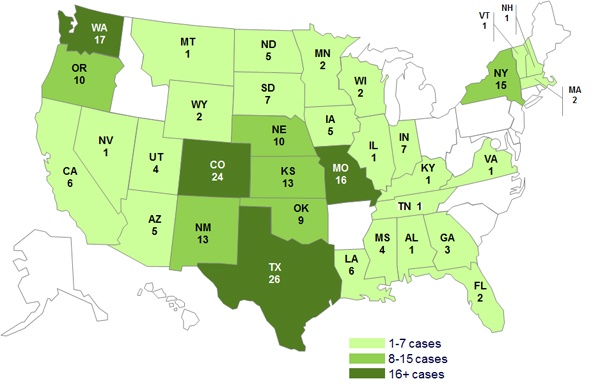
| June 2013 | |||||||||||
| Top stories | |||||||||||
| In the news | |||||||||||
| Photos | |||||||||||
| Contact us | |||||||||||
| Archive | |||||||||||
|
Multistate outbreak of Salmonella linked to poultry |
The Centers for Disease Control and Prevention reported on June 6 that 224 people, including five Iowans, have been infected with the outbreak strain of Salmonella Typhimurium. The CDC reports that the nationwide outbreak has been linked to live poultry. Only one of the five Iowa cases has been traced to a poultry exposure.

Randy Groepper, clinical lab technical specialist, conducts slide agglutination testing to detect Salmonella.
The State Hygienic Laboratory is working with CDC and the Iowa Department of Public Health (IDPH) to identify cases of illness that may be part of this outbreak.
The CDC reported that laboratory, epidemiologic and traceback findings link reported cases in 34 states to contact with chicks, ducklings and other live baby poultry purchased from multiple feed stores and mail-order hatcheries. The reported illnesses began between March 4 and April 26, with 62 percent affecting children 10 years old or younger.
Hygienic Laboratory scientists and other public health investigators are using a national subtyping network known as PulseNet to identify cases of Salmonella in this outbreak. They use the technique of pulsed-field gel electrophoresis (PFGE) to extract the DNA of Salmonella from an isolate, and then compare it to DNA from confirmed cases already stored in the PulseNet database.
The first step in this process begins with the physician.
“Detection of clusters or outbreaks of Salmonella is possible through the coordinated effort among physicians, clinical labs, IDPH and the Hygienic Laboratory,” said Mary DeMartino, interim director of the Hygienic Laboratory’s Disease Control Division. “Physicians order stool cultures, which are sent to clinical labs for culture.
“When a clinical lab isolates the organism, they send it to the Hygienic Lab for complete identification and PFGE. The DNA fingerprints from PFGE allow us to determine patient isolates that are related, which may indicate that all the patients became ill from a common source. IDPH conducts the epidemiological investigation to identify the potential source of infection and any additional patients who may be ill.”
To reduce the risk of Salmonella infection, the CDC recommends the following:
- Wash hands thoroughly with soap and water after touching poultry or anything in the area where they live.
- Adults should supervise hand washing of young children.
- Children under five, older adults or anyone with a weak immune system should not handle live poultry.
- Do not snuggle, kiss or touch birds with the mouth.
- Do not eat or drink around live poultry.
- Keep live poultry out of the house.
- Do not give live poultry as gifts to young children.
CDC provides additional information to reduce the incident of infection and illness related to handling live poultry.

The CDC reported 224 cases of Salmonella Typhimurium linked to live poultry in 34 states, including Iowa, as of June 4.